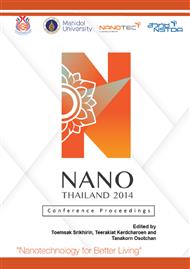[1]
J. Zhu and M. Zach., Current Opinion in Colloid & Interface Science, 14(2009), 260-269.
Google Scholar
[2]
V.K. Mahajan, S.K. Mohapatra and M. Misra, Int. J. Hydrogen Energy, 33(2008) 5369-5374.
Google Scholar
[3]
O'Regan B, Grätzel M, Nature 353(1991), 737–739.
Google Scholar
[4]
M.A. Green et al. Prog Photovoltaics Res. Appl. 17(2009), 320-326.
Google Scholar
[5]
Poulomi Roy, Sergiu P. Albu, Patrik Schmuki, Electrochemistry Com. 12(2010) 949-951.
Google Scholar
[6]
V. Zwilling, M. Aucouturier, E. Darque-Ceretti, Electrochimica Acta (45)1999, 921–929.
DOI: 10.1016/s0013-4686(99)00283-2
Google Scholar
[7]
H. Park et al, Solar Energy Materials & Solar Cells. 95(2011) 184-189.
Google Scholar
[8]
J.H. Park, S. Kim and A.J. Bard, Nano Lett. 6(2006), 24-28.
Google Scholar
[9]
Y.Y. Zhang, W.Y. Fu and H.B. Yang, Appl. Phys. Lett. 82(2003), 281-283.
Google Scholar
[10]
Hu Tian, Junfeng Ma, Kang Li, Jinjun Li, Ceramics Int. 35 (2009), 1289-1292.
Google Scholar
[11]
Soon H. K, Wonjoo L., Yoon-Chae N. et al, Current Applied Physics 13(2013), 252-255.
Google Scholar
[12]
Z. He et al, Ceramics International 39(2013), 5545-5552.
Google Scholar
[13]
H. Xu et al, Applied Surface Science 257(201), 8478-8480.
Google Scholar
[14]
J.M. Macak, H. Tsuchiya and P. Schmuki, Angew. Chem. Int. Ed. 44(2005), 2100-2102.
Google Scholar
[15]
Hailei Li, Lixin Cao, Wei Liu, Ge Su, Bohua Dong, Ceramics Int. 38(2012), 5791-5797.
Google Scholar
[16]
Ning Liu, Kiyoung Lee, Patrik Schmuki, Electrochemistry Com. 15(2012), 1-4.
Google Scholar
[17]
Bing-Xin Lei, Qiu-Ping Luo, et al, Advanced Powder Technology 24(2013), 175-182.
Google Scholar
[18]
S. Bauer et al, Electrochemistry Com. 13(2011), 538-541.
Google Scholar
[19]
Srimala S. et al, Journal of Alloys and Compounds 485(2009), 478-483.
Google Scholar
[20]
U. Tipparach et al, J. Nat. Sci. Special Issue on Nanotechnology. 7(1) (2008), 129-136.
Google Scholar
[21]
Shih-Yu Ho., Chaochin Su, et al, Thin Solid Films 529(2013), 123–127.
Google Scholar
[22]
Hee Yeon H et al. Solar Energy 85(2011), 1551-1559.
Google Scholar
[23]
J.M. Macak et al, Journal of Electroanalytical Chemistry. 621(2008), 254-266.
Google Scholar
[24]
Rui Liu et al, Thin Solid Films. 519(2011), 6459-6466.
Google Scholar
[25]
Ho Chang, Chih-Hao C., Mu-Jung K., et al, Applied Surface Science 275(2013), 252-257.
Google Scholar
[26]
Hun Park et al, Solar Energy Materials & Solar Cells. 95(2011), 184-189.
Google Scholar


